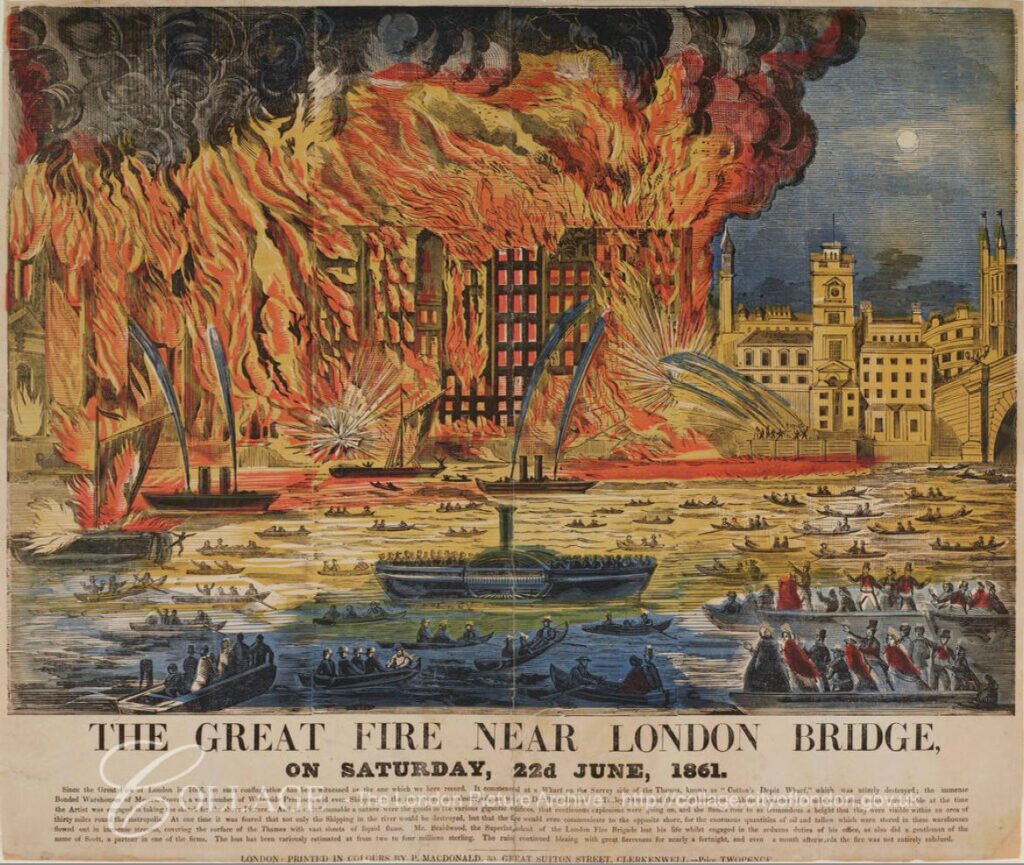Have you ever paused outside Liverpool Street Station and looked across the road to admire this magnificent building …

Its Grade II listing describes it as a ‘lavish pastiche of Tudor gothic style in red brick and Portland stone’ and ‘lavish’ seems a very appropriate word. Built in 1888, it is a typical expression of Victorian civic pride with its original purpose still clearly visible 135 years later …

Sadly, however, beyond the arches there no longer resides the great engines and brave crews who used to keep Londoners safe but a retail outlet for Tesco.
Fire services in London emerged principally from the need for insurance providers to limit their losses through damage to property in the period after the Great Fire of 1666. Initially, each insurer maintained a separate brigade that only served subscribers until the foundation of an integrated service in 1833, funded by City businesses. A terrible fire in Tooley Street prompted a radical review of firefighting in London – read all about it in my earlier blog.

Image credit: London Metropolitan Archives, City of London: catalogue ref: p5354642
The first publicly-funded authority charged with saving lives and protecting buildings from fire was founded in 1866: the Metropolitan Fire Brigade (MFB), initially part of the Metropolitan Board of Works whose initials are still displayed on the building …



The earliest stations were generally plain brick and few pre-1880 examples survive. In the 1880s, under the MFB architect Robert Pearsall, fire stations acquired a true architectural identity, most notably in the rich Gothic style typical of Victorian municipal buildings such as Bishopsgate.
Let’s take a closer look.
The spandrels above the arches include the coat of arms of East Anglia (3 crowns) and Essex (3 swords) …

There’s also Kent (white horse) and Norwich (Castle) …

Plus the City of London (St George’s cross with sword of St Paul) and the Houses of Parliament (portcullis) …

From a distance you can admire the Victorian watch tower – literally for keeping a look out for fires from the top of the building …

Can you see the discreet Livery Company coat of arms?

Here it is in close-up …

The arms belong to the Goldsmith’s Company who probably own the freehold to the building.
I’ve been searching the archives for images of the Station in its heyday and here’s what I found.
The Station in 1907 (Image copyright London Metropolitan Archives / City of London Corporation)..



You can see more images using these links:
The first retail outlet in the 1970s.
This 1904 picture isn’t of the Bishopsgate Station but it does show an interesting combination of horse-drawn and mechanical engines …

London’s oldest fire station was based in Clerkenwell but was closed down in 2014. Read all about it here in The Gentle Author’s blog.
This might be a good time to remember the bravery of individual firefighters and a Clerkenwell station ‘escape attendant’ called George Lee is commemorated on the Watts Memorial in Postman’s Park where brave police officers are also remembered.

At the inquest into George’s death the chief officer giving evidence declared that ‘after a very long experience he believed this was the greatest act of bravery ever shown by any fireman in the world’. There is a really comprehensive description of the event and George’s extraordinary courage here on the London Walking Tours website. Incidentally, I’m grateful to Katie Wignall of the Look Up London website for inspiring today’s blog – the picture of the watchtower and the coat of arms are from her blog.
Finally, as regular readers will know, I do tend to pay particular attention to bollards and have devoted a blog to them entitled Bollardology. I couldn’t resist, therefore, taking a picture of these rather colourful examples at Citypoint …

If you would like to follow me on Instagram here is the link …


















































